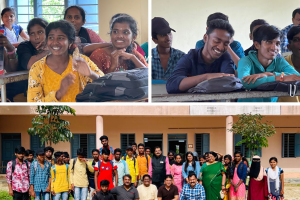Edited Excerpts from the Viewpoint Roundtable September 20, 2014 at Chez Nini, Delhi
Participants:
Kulmeet Bawa, Director Enterprise – South Asia, Adobe
Rahul Matthan, Founding Partner, Trilegal
Venkat Mallik, President, RAPP India
Moderator: Shane Jacob, Vice President, Digital, The Practice
The first Viewpoint Roundtable brought together a senior marketer, an experienced digital strategist, and a legal expert for a stimulating panel discussion on trends and issues related to digital marketing.
For something as ubiquitous as digital marketing, it is surprising how hard it is to pin down – when it comes to outlining strategies, demonstrating ROI or understanding the gray areas to avoid.
The goal of the discussion was to provide some tools and ideas for marketers to tackle these blind spots. A highly engaged audience helped to make this an interactive and insightful session, the first of many more to come.
We hope that these insights, along with the digital marketing case study that follow them, will provide some ideas and inspiration for future campaigns.
DATA FROM THE APAC DIGITAL MARKETING PERFORMANCE DASHBOARD
Kulmeet: The CMO Council, in partnership with Adobe, conducts one of the best surveys in digital marketing. The results are captured in the Digital Marketing Performance Dashboad, or the Digi-Dash, as we like to call it. The findings of the APAC survey, which will be released shortly, includes measures across four parameters – market mindset, marketing readiness, organisational alignment and marketing skill sets. The market mindset figure is favourable to India, in that 96% of those surveyed in India believe digital marketing is a huge competitive advantage. While APAC ratings are 6.7 on a scale of ten, India’s is slightly lower at 6.6. The disappointing part though is that only 55% believe they are engaging and activating audiences in the correct manner.
The Digi-Dash also reveals a dip of close to 10% in senior management mindshare where digital is concerned. This can be linked to my earlier point of a lack of customer engagement. Are we creating enough value to demand digital advocacy from senior leadership?
There are some other numbers that are also worrying. The biggest one is that only 6% of India believes they are using data correctly. We are below the APAC average on this front and if we have to create value, we need to understand how to use data appropriately.
WHAT’S REALLY HAPPENING ON THE GROUND
Venkat: The newest statistics are mind boggling: there are 243 million people on the internet in India – more than half of them are on the mobile and we have over 100 million Facebook users; about 55 million to 60 million people watch videos every day; and about 4 billion is the number of video views in a month.
So, digital is clearly here to stay. In a country of about a billion people where 60% of people are almost below poverty line, you are dealing with 400 million people who can have and afford anything at all. This is the audience that is relevant to marketers.
If that is true, then you should be seeing a lot of money coming into the internet. The reality is that that is not happening. For example, India is the second largest country [for Facebook] but what you may not know is that less than 1% of Facebook’s revenue comes from India. So, that gives you a vivid picture of where we are at with this whole phenomenon. There are very few marketers who spend more than 5% or 10% of their money on digital.
And therefore, the whole industry is actually trying to go around building statistics to prove that it’s an effective medium at this particular point in time. There are different categories which deal with this medium differently. But what we are also finding is that there is a disproportionate amount of interest in the medium.
In China, for example, the advertising market is now believed to be anywhere from $60 billion to $70 billion. Of this, 17 billion is tied to the internet and, more specifically, to digital television. India’s advertising market is about 6.5 to 7 billion. However, even with this difference in scale, we are seeing some of the same trends emerging. We are beginning to see digital radio, TV and newspapers in India also, and people turning to this medium for news and entertainment consumption.
It’s become like an infrastructure which actually impacts everybody but when it comes to communicating and dealing with consumers, the rules are the same.
THE LEGAL PERSPECTIVE & ETHICAL DILEMMAS
Rahul: A lot of the issues that come to us as lawyers, do so after the fact, when something really bad has happened. The digital platform provides instant feedback along with the potential for messages and ads to go viral. But in chasing after viral content, we often tend to trip up. The challenge really is that if you trip up on digital, the impact that you will suffer as a brand is very significant.
However, from a legal perspective, that’s not really the only problem you need to deal with. The digital age has given us access to unprecedented data and its usage poses some dilemmas for marketers. One of the most unsettling stories that I have heard in this regard, involves a very large retail company in the US.
As part of a targeted marketing campaign, the company sent a booklet of coupons to be redeemed against baby products, to the father of a young teenage girl. The retail company, through a system of very sophisticated algorithms – having nothing to do with the actual purchase of a baby product and more to do with the fact that, at an early state of pregnancy, women move from scented products to unscented products – was able to predict pregnancy with an alarming level of accuracy. This was knowedge that neither the father nor the daughter were privy to until that point. The company did nothing wrong at the end of the day. They did not snoop into any private, personal activity of this person. They only gathered this information from shopping habits, in their own store.
For obvious reasons, data can be very valuable to marketers such as yourself. But this particular case highlights the Spiderman truism: With great power comes great responsibility.
How marketers use this powerful data is not a question of law. It’s a question of ethics. There are decisions that you will make that could influence individual action and reaction, only because you have access to hidden insights about that person. In those circumstances, how you would react is not a legal question. It is an ethical question.
DATA AND CONSUMER TARGETING
Venkat: Typically you get insights, like the ones that Rahul described in his cautionary tale, by conducting a market basket analysis. You look at the purchases that people have made over a period of time, pick trends from there, and then cross pollinate that with demographic data if you have access to it. You can then uncover insights which allow you to sharp target and increase the relevance of your marketing messaging.
You may have heard about the Australian case study involving the purchase of diapers and beer on Thursdays. Through the kind of analysis I have just described, retail marketers in Australia found out that people leaving for weekend trips on Friday afternoons, make sure that they are stocked up on both beer and diapers before loading the kids into the car and driving off. So, there is a definite pattern of those items being bought together towards the latter part of the week. This is an example of a counterintuitive insight that emerged from the analysis. When they started stocking the two items together on store shelves, sales of both went up.
Clearly, all of these insights allow us to get smarter. The ethics of it only arises when the strange stories come up. Without big data and the levels of smartness and relevance that it makes possible, people would be getting irrelevant communication every day. If you can truly create relevant communication for people, you are actually doing the world a big service.
CONTENT STRATEGIES THAT WORK FOR BRANDS
Venkat: The one big lesson that you learn in advertising is that the medium is more important than the message. The medium is the piece of content that goes out, such as the video. The video is more important than the brand message because, if the video doesn’t reach you, the brand message will never get to you. Since you live in a world of permission marketing, you choose whether the video gets to you or not. If you find it relevant, you will pick it up and if you don’t, you are going to reject it.
One of the things that we propagate when we talk of social media, is something called the life role. If I don’t fulfill a life role that you are seeking, then I will not be relevant to you and you will never come back to me.
I will give an example with a brand that will help. This is a brand called Knorr – a Unilever Brand – which is all about flavorful cooking and chefmanship,
The India insight we uncovered for the brand was this: There are many homemakers or working women in the country who are actually trying to cook meals in the house. Those women and their dining tables are competing with restaurant food.
Our idea was to be the brand that enables women to put magical meals on the family dining table everyday. We went through the steps of how to make that meal magical (e.g. light a candle), as much as we talked about infusing flavor into cooking. With an internet strategy built on this insight, the brand became relevant to the target consumer.
DATA AT THE HEART OF IT ALL
Kulmeet: We have to start getting personalization to the next level for the online consumer and start using this data. We have a concept called the digital shelf at Adobe. We say that data, in all its forms, is beautiful and it paints a complete picture of your customer. In that picture lie those small little critical insights that you would love to know about that individual in the online world.
Now if you do not capture data in all its entirety, you would never isolate those critical little insights, which is what can finally bring meaning to the experience of the online customer.
PRIVACY RIGHTS UNDER THE LAW
Rahul: There is currently no Indian data privacy law. What we do have are a set of regulations under the Information Technology Act that govern specific types of information. However, just because we have no laws and because we can violate privacy in ways that would not be permissible in the US or Europe, doesn’t mean you can do so for an international brand in India. Or even for a domestic brand, because your reputation is more than what the law says you can or cannot do.
In the very first course in Law – Legal Method – we are asked the question: ‘What is Law?’ The answer is Law is minimum morality. We take what everyone believes to be the basic minimum moral standard to operate under and we call that Law. We always operate at a threshold much higher than that. Ethics is that higher threshold.
Digital Marketing Case Study
The Launch of Coke Zero in India
In India, Coca Cola has a dedicated digital monitoring group named ‘Samvaad’ (conversation) that tracks every thread, blog or post that is directly or indirectly linked to the brand. Through this focused activity, Coca Cola India generates plenty of data and insights that the brand can tap for its digital campaigns.
A recent campaign centered around the India launch of its sugar free drink, Coke Zero, presents a case study in effective use of digital marketing. Coke Zero is positioned as a drink for men who want the taste of the original without the sugar and calories. In contrast, its other leading cola product, Diet Coke, has a slight female skew.
There was already some buzz about Coke Zero in the market as it had previously been launched in other countries. The company used this product awareness to its advantage in order to create anticipation for the upcoming launch in India.
The choice of celebrities and performers (Mahesh Bhupathi, Farhan Akhtar, Indian fusion band Advaita) for the launch events in Delhi and Bangalore was in keeping with the product marketing strategy of targeting Indians with cultural and global exposure.
There were two main factors that primarily contributed to the success of the launch. The first was Twitter. As tweets by celebrities at the launch were picked up by their many fans, it amplified the reach of these standalone events. The other part of the brand’s winning launch strategy hinged on its arrangement with Amazon India for pre-booking orders for Coke Zero. This arrangement gave consumers an easy way to get their hands on the product as soon as supplies were available in the country. In short, the launch combined good marketing and distribution in a strategy backed by sound consumer research.
Details and numbers provided by Deepak Jolly, VP – Public Affairs and Communication, Coca Cola India
Some numbers from the launch:
76 million impressions
11,000 stories created
7,500 unique users
1,450 live viewers
2,700 website views
10,100 web page views
32,000 cans of Coke Zero pre-ordered on Amazon.in within 48 hours
100,000 cans were pre-ordered within 2 weeks of the launch




